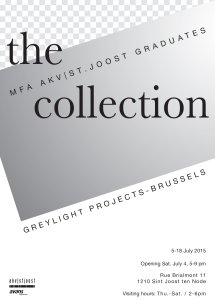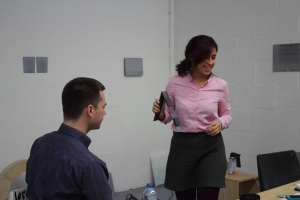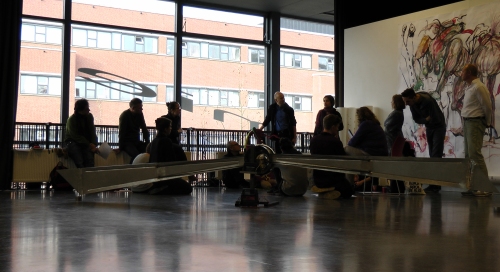MFA tutor Bas van den Hurk exhibits at P/////AKT, Amsterdam with Hans Demeulenaere (B) and guest artists Koenraad Dedobbeleer (B) and Lorelinde Verhees.

“By taking aesthetic responsibility in a very explicit way for the design of the installation space, the artist reveals the hidden sovereign dimension of the contemporary democratic order that politics, for the most part, tries to conceal.” – Boris Groys
Politics of Installation is a two-part dialogue between Bas van den Hurk and Hans Demeulenaere, in which they examine their own and each other’s practice, in order to form a new series of works and presentation models together. After the first part in Loods 12 in Wetteren (B), the final part is now presented in P/////AKT. A combination of new works and parts of the previous show, will be displayed in a new arrangement.
Bas van den Hurk’s work is on the verge between painting, fashion, sculpture, installation, architecture and performance, by which he addresses the process of making in its various forms. Hans Demeulenaere plays with the perception of space. His work consists of objects, constructions and frames which integrate both sculptural and daily elements. In Politics of Installation, a title that is derived from a text by Boris Groys in 2009, the artists ask themselves to what extent the making of an installation can attach certain (political) meanings to a space. How do we relate to a shared space? How do we negotiate its use and meaning?
The binding factor in the work of Van den Hurk and Demeulenaere is the changing relation between autonomy and heteronomy. For this reason, they offer multiple points of view in this exhibition. They invited guest artists Koenraad Dedobbeleer and Lorelinde Verhees to make a contribution, as well as several text writers and especially the audience. In this way, the physical space of P/////AKT becomes a ‘place for negotiation’, where the artists engage in a dialogue on the work and the arrangement of the space. Art work and exhibition element will merge somewhere between showing and looking.
Also, an art historical line will be drawn by means of architectural interventions. Bas van den Hurk (re-)constructs a concrete circular element, based on the work of Belgian architect Juliaan Lampens, who introduced the ‘open plan living’ in the 1960’s. He will also present clothing works in collaboration with Sanne Jansen, paintings and bottles with remains from the painting process. Hans Demeulenaere shows a combination of existing and new work, amongst which a reconstruction of a part of the Sonsbeek-pavilion from 1965-’66, built by Aldo van Eyck. Recently, this pavilion was rebuilt in the sculpture garden of Kröller-Müller Museum.
Politics of Installation, part 2 is the third exhibition in the series Not Making Sense As Something Else, which is reflected upon by Freek Lomme (moderator) and Marnie Slater (writer).
http://www.pakt.nu































































